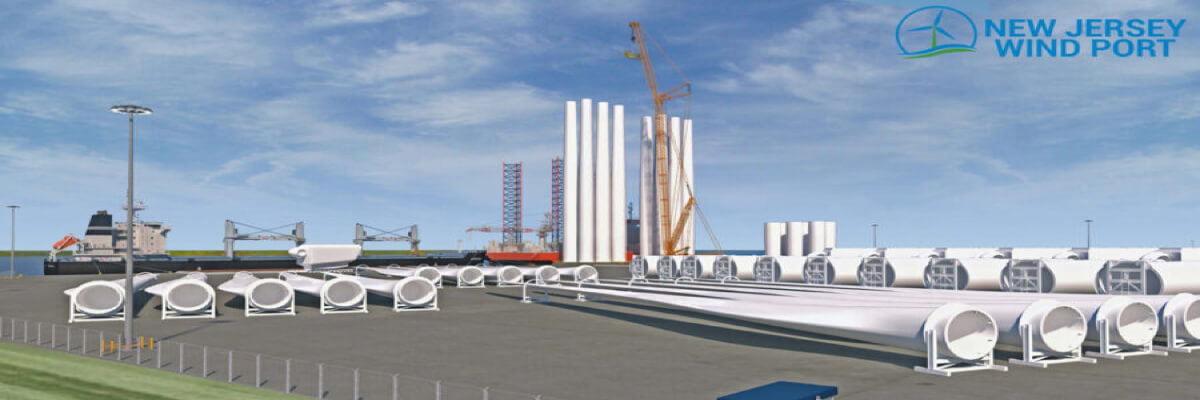Wind Port Construction Begins to Boost Economy

New Jersey’s wind port, a major economic bet on the East Coast’s budding offshore wind industry, is in its early stages of construction but has already signed contracts with some local businesses including those owned by minorities and women, state officials said.
The Economic Development Authority, an agency overseeing the state-financed project, said about 50 people were employed at the port’s Salem County site by mid-March, and that number was expected to grow to around 200 when the pace of construction increases later this year.
The port, costing a projected $300-400 million in public funds, will be constructed using union labor under a project labor agreement. Trades workers include operating engineers, dock builders, carpenters, iron workers, electricians and concrete finishers, the EDA said.
South Jersey businesses account for a “significant proportion” of the services contracted so far, and include several based in Salem County. “We anticipate that southern New Jersey-based businesses will continue to see a sizeable share of future contract awards for construction and related services,” the agency said.
Job numbers
The project is due to be completed in late 2023 and is expected to create some 1,500 permanent jobs in manufacturing and operations, including assemblers, computer programmers, drafters and fabricators. In addition, the EDA said it expects “several hundred” jobs to be created during construction.
The port, being built on a 200-acre site next to the Salem nuclear plant on the Delaware River at Lower Alloways Creek, will provide space for the marshaling, assembly, manufacturing and servicing of hundreds of wind turbines expected to be constructed off the East Coast over the next decade.
Gov. Phil Murphy, at a ceremonial groundbreaking for the project last September, said the port will establish New Jersey as the “epicenter” of the East Coast’s offshore wind industry, and the focus of its supply chain.
The facility is designed to service the two wind farms planned off Atlantic City and Long Beach Island, as well as about a dozen scheduled to rise off at least seven other coastal states between now and 2035.
New Jersey officials say the port will be the nation’s first purpose-built facility of its kind. And, they said, it will be well positioned at the heart of the East Coast to service the burgeoning industry — which is being nurtured by commitments by at least eight states to buy offshore wind power, and by the Biden administration’s promotion of offshore wind as a way of meeting its clean-energy goals.
One of a kind
The site was chosen because of its proximity to the ocean, and the fact that there are no vertical barriers such as bridges for the giant wind turbines, which are carried vertically from the shore to their ocean sites. The turbines will tower up to 850 feet above the water line when they are installed.
Kris Ohleth, director of the University of Delaware’s Special Initiative on Offshore Wind, a research and analysis group, said the port is so far the only purpose-built facility of its kind in the region, and will be in high demand from the many wind farms that are being planned off the East Coast. She said it will be well positioned at the geographical center of the East Coast’s wind industry.
“The state’s contribution to the offshore wind sector via the development of this port demonstrates New Jersey’s strong commitment to supporting this new industry that will deliver clean, reliable energy as well as an economic boon for its citizens,” Ohleth said.
To spread the economic benefits, the EDA aims for 15% of construction value to be taken by minority, women, and veteran-owned firms. Within the total, the agency aims for 18% of the businesses to be minority-owned, and 6.9% owned by women.
Monitoring workforce diversity
The EDA said it holds monthly meetings of a committee dedicated to ensuring diversity of the port’s workforce, and in December co-hosted a careers fair, along with the lead contractor AECOM Tishman, and the Southern New Jersey Building Trades Council, to highlight opportunities for Salem County residents for construction jobs related to the port.
Asked whether the anticipated influx of workers will create demand for transit links to the remote coastal site, EDA spokeswoman Rachel Goemaat said the agency is assessing whether public transportation is needed, and will work with state and local governments if that need is identified. The agency does not expect demand for housing to exceed local supply as a result of the expanded work force, she said.
Murphy has set a goal of the state procuring7,500 megawatts of offshore wind power by 2035, or enough to run around 3.4 million homes — the second-largest commitment among Atlantic Coast states, after New York, which has agreed to buying 9,000 MW, also by 2035.
The two New Jersey wind farms scheduled so far — Ocean Wind, about 15 miles off Atlantic City, and Atlantic Shores between Atlantic City and Barnegat Light on the northern tip of Long Beach Island — would generate about a third of Murphy’s goal. Neither has started construction; Ocean Wind is due to begin generating power by late 2024.
Underscoring the state’s commitment to offshore wind, the EDA said Thursday it will provide $1 million to four universities to advance research and investment in workforce training for the industry.
The new money will fund research by 24 students into offshore wind development, under the EDA’s Wind Institute, which coordinates research and innovation in the industry.
EDA chief executive Tim Sullivan said he welcomed $5 million for the Wind Institute in Murphy’s proposed budget for the 2023 fiscal year.
Sullivan said the budget item “serves as a testament to the state’s commitment to accelerating economic growth, meeting our clean energy goals, and investing in a robust, diverse, and experienced workforce.”
Read the full article here.